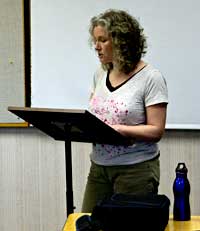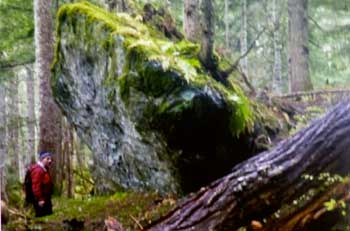The Northern Gateway Joint Review Panel questioning hearings and final arguments will bypass Kitimat and most of the communities along the proposed pipeline route, according to a letter to all intervenors from the JRP prompted by questions from the Gitxaala Nation.
The Joint Review Panel has not yet issued an official and final procedural directive concerning the final hearings, and in response to the Gitxaala letter, the JRP secreteriat will convene a conference on May 30, in Calgary to set up that procedure. The three panel members will not be present at the conference.
In the letter to the intervenors, the JRP proposes:
Final hearings for questioning will take place in three locations. The Panel intends to hold these hearings in Prince Rupert, BC, Prince George, BC and either Edmonton or Calgary, AB. These locations are centrally located, have adequate facilities and reasonable transportation access. Would fewer than three locations be appropriate? What are your comments on the locations chosen by the Panel?
As for the final argument hearings, the Joint Review Panel says:
The Panel anticipates allowing parties to present final argument either: (i) orally;
or (ii) in writing. On an exception basis, parties may request permission of the
Panel to allow final argument on a specific topic both in writing and orally.
The Panel anticipates holding hearings for final argument in two locations;
namely Prince Rupert, BC and either Edmonton or Calgary, AB. Mechanisms will
be established to allow parties to participate remotely (i.e. via telephone or other
electronic means). Do you have any input on these locations?
For the questioning period, the Joint Review Panel says it anticipates that it will sit from Monday to Saturday for two week periods, followed by a one week break. Standard sitting hours would be from 8:30 a.m. to 1:00 p.m.
Cheryl Brown, representing the Kitimat group Douglas Channel Watch, has already objected to the fact the Joint Review Panel has apparently decided to bypass Kitimat.
The location of the panel should include Kitimat as it is the community
experiencing the highest impact from the project -land and marine. The citizens
of Kitimat need to have the opportunity to hear the proceedings and how it will
potentially impact their future. Accommodations can be provided in Terrace with
bus transportation provided if needed and this is standard practice for other large
events. Air travel into Terrace/Kitimat is reasonable with good transportation to
Kitimat. Rupert has some exposure to the project but to justify that the hearings
take place there due to adequate facilities, that it is central and has reasonable
transportation access is not valid. Rupert is not central for the Northwest and the
issue of getting from the terminal to the city by ferry is hardly reasonable.The proposed schedule seems adequate. For intervenors with limited financial
resources any length of stay outside their own area can be difficult.
Note that in its letter the JRP asks: “Would fewer than three locations be appropriate?” There is no suggestion that the number of locations be expanded.
This is despite the fact throughout the hearings, Sheila Leggett, the chair has repeatedly told intervenors in each location to hold back their comments until the final hearings. In addition, during the intervenor phase of the hearings, questioning was not permitted, only statements on local or traditional knowledge.
The JRP letter to intervenors goes on to say
The Panel intends to have questioning on oral evidence completed prior to
questioning based on written evidence pertaining to the List of Issues.
Questioning of witness panels will proceed at each location based on issues.
These issues largely mirror the List of Issues set out in the Hearing Order (dated
5 May 2011) and discussed in the Panel Session Results and Decision (dated
19 January 2011). The Panel intends to address each issue listed below in
relation to the entire Project at only one location. The location for each issue is
as follows:Prince Rupert
(a) Potential Impacts of the Proposed Project on Aboriginal Interests
(socio-economic matters; asserted and proven Aboriginal and treaty
rights)
(b) Environmental Effects
(c) Socioeconomic Effects
(d) Consultation (with the public and Aboriginal groups)
(e) Safety, Accident Prevention and Response (related to the marine
terminal and marine transportation)Prince George
(a) Potential Impacts of the Proposed Project on Landowners and Land
Use (pipeline crossings; depth of cover; impacts on agricultural soils)
(b) Routing (general route of the pipeline and route selection criteria).
General location of the facilities and siting of a marine terminal.
(c) Design, Construction and Operation
(d) Follow up and monitoring
(e) Safety, Accident Prevention and Response (related to the pipeline)Edmonton or Calgary
(a) Need for the Proposed Project (supply and markets; commercial
support; economic feasibility)
(b) Potential Impacts of the Proposed Project on commercial interests
(c) Financial and Tolling Matters (tolling structure and methodology;
proposed financing; financial responsibility of the applicant)
The letter asks, “Do you have any additional issues for each hearing location or any input on the general format identified?”
It also asks intervenors questions like: “What parties’ witnesses do you anticipate questioning during the final hearings? What issues do you anticipate you will ask questions about? How much time do you anticipate you will require for questioning for each issue?
The panel says it is considering a process for expert witnesses which would entail having expert witnesses for parties with conflicting opinions seated together in a single witness panel and questioned at the same time, mainly about issues that “are highly technical in nature” so the panel can “assess complex expert evidence, understand differences, and focus on certain technical issues in an efficient manner.”
The letter goes on to say that the panel intends to permit “questioning of witnesses by telephone and is exploring other remote means.”
However, the letter to the Joint Review Panel from Cheryl Brown of Douglas Channel Watch clearly shows the kind of problems faced by those “directly affected” by the pipeline if they live in rural northwestern British Columbia.
Technology is limited as I am rural and do not have high speed internet. Could
the use of local video conferencing facilities be utilized. The panel needs to consider that there are many intervenors that are independent in the process and do not have resources to participate that others may have. It bears on the JRP
to ensure there is the ability of all to participate in the process in a reasonably fair and equitable way and the panel needs to consider other ways to configure the hearings
Telephone questioning during the NEB KMLNG (Kitimat LNG) hearings in Kitimat in June was awkward to say the least, and often plagued by technical problems in getting lines up and staying connected. Telephone questioning also meant that the energy industry lawyers actually in the hearing room at Riverlodge had a distinct advantage over the remote questioners.
The letter of the Joint Review Panel by Cheryl Brown of Douglas Channel Watch also outlines the issues the environmental group will be trying to bring before the panel:

Here are issues that need to be addressed within the communities highly affected
i.e. Kitimat
•Routing: through the tunnel and the difficult terrain of the Kitimat River,
•Siting of the marine terminal,
•Safety, accident prevention response related to the terminal and marine
transportation, environmental effects on the estuary, Douglas Channel
and marine route.
•Socioeconomic and environmental effects are different across the entire
pipeline. To address then in one place does not allow for adequate
participation by intervenors from other areas to address the areas that are
of concern. A significant number of intervenors are without funding and
are privately involved in the process. The hearings have to acknowledge
this.
•Aboriginal interests are unique to different areas and the costs for travel to
one place would be a burden.
•Consultation with the public needs to be represented in more locations.
The public that has been involved as intervenors do not have resources to
travel. The panel needs to consider this.
Brown goes on to say that the use of expert panels “sounds interesting” but she adds she is “not sure how one would interact with the panel. More details are required.”
The Joint Review Panel’s proposed schedule, which basically eliminates effective participation by those most affected by the pipeline, raises a key question at the national political level. Is the fact the panel is skipping most of the communities involved a return to the National Energy Board tradition that it is nothing more than a private club for Calgary energy lawyers or is it a result of pressure from Prime Minister Stephen Harper and Natural Resources Minister Joe Oliver to speed things up?
The controversial Enbridge Northern Gateway twin pipelines, if approved, will transport bitumen from Alberta to the port of Kitimat and condensate from Kitimat to Alberta. Although there is significant opposition to the pipeline in British Columbia, Prime Minister Stephen Harper has made clear the pipeline is a national priority. Natural Resources Minister Joe Oliver has repeatedly condemned people who oppose the pipeline as “radicals.”
Update: District of Kitimat, Haisla Nation to question JRP schedules bypassing Kitimat
In separate e-mails to Northwest Coast Energy News, Kitimat mayor Joanne Monaghan and Haisla Nation Chief Counselor Ellis Ross both say they will be file objections with the Joint Review Panel questioning the JRP’s position in bypassing Kitimat in both the questioning round and final arguments.
JRP Procedural Direction No 7 (pdf)
JRP letter to all parties Procedural Conference on Final Hearings (pdf)
Letter to JRP from Cheryl Brown of Douglas Channel Watch (pdf)






 Dieter Wagner, of Douglas Channel Watch, briefs District of Kitimat Council on the perils of Wright Sound, Oct. 17, 2011. (Robin Rowland/Northwest Coast Energy News)
Dieter Wagner, of Douglas Channel Watch, briefs District of Kitimat Council on the perils of Wright Sound, Oct. 17, 2011. (Robin Rowland/Northwest Coast Energy News)